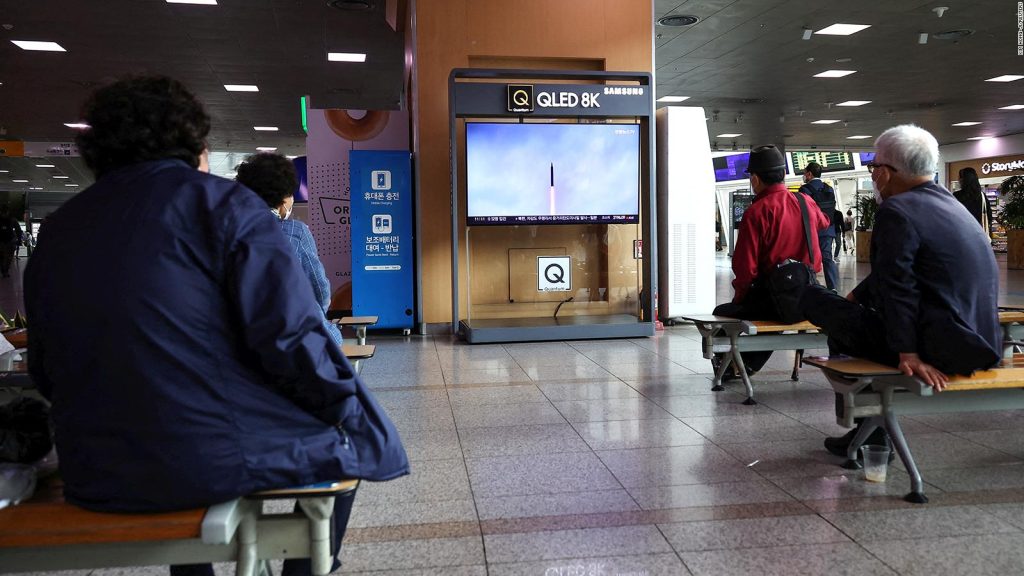(CNN) – North Korea A ballistic missile was launched without warning over Japan On Tuesday, for the first time in five years, a highly provocative and reckless act marked a major escalation in the weapons testing program.
The missile flew over northern Japan in the early morning and is believed to have landed in the Pacific Ocean. The last time North Korea fired a ballistic missile at Japan was in 2017.
This marks North Korea’s 23rd ballistic missile launch this year, and is also the most launched in a single year since leader Kim Jong Un took power in 2012. By comparison, Pyongyang conducted four tests in 2020 and eight in 2021.
Here’s what you need to know about North Korea’s missile tests.
What do we know about the missile?
Tuesday’s missile traveled about 4,600 kilometers (2,858 miles), an altitude of about 1,000 kilometers (621 miles) and a top speed of Mach 17, 17 times the speed of sound, according to Japanese officials.
For comparison, the US island of Guam is located 3,380 kilometers (2,100 miles) from North Korea.
Two experts told CNN that these flight details indicate that the missile launched was likely a Hwasong-12, an intermediate-range ballistic missile (IRBM) that was last tested in January.
“This is a missile that North Korea started testing in 2017…so it’s not really a new missile,” said Jeffrey Lewis, director of CNS’s East Asia Nonproliferation Program.
But, he added, launching it is important because of the distance it can go.
“North Korea has a lot of missiles with shorter range, and those missiles won’t pass over Japan, but they have a small number of missiles that can make that flight,” he said.
Why is this so important? Is there a danger?
North Korea routinely launches its missiles into waters off the coast of the Korean Peninsula, making this flight over Japan even more provocative, both for practical and symbolic reasons.
This type of unannounced launch may present risks to aircraft and ships as the missile moves toward its target, as they would not have advance warning to avoid the area.
And if the test fails, causing the missile’s trajectory to malfunction, it could put large population areas at risk. The missile flew over Japan’s Tohoku region, according to Japan’s Chief Cabinet Secretary Hirokazu Matsuno, which is home to more than 8 million people.
In the past, US planes have been grounded as a precaution after a North Korean missile launch. And in late November 2017, it was reported that several commercial aircraft pilots saw what appeared to be a re-entry of a North Korean missile as it approached the Sea of Japan.
However, Lewis emphasized that such risks are statistically low, especially in the Pacific and elevated over Japan in flight. It is mostly an escalation simply because “it is a provocation to launch a missile at your neighbour”.
“For the Japanese in particular, it looks like a violation of their sovereignty,” Lewis said. “If Russia launches a missile over Florida, we will attack,” he added.
Experts say it is a sign of Kim’s ambitions to develop North Korean weapons and things to come.
Why did North Korea launch the missile now?
There are mixed opinions about what may have prompted North Korea to launch a missile on Tuesday.
Robert Ward, senior fellow for Japanese security studies at the International Institute for Strategic Studies, noted the multiple security threats Japan faces, from aggressive Russia to the north and China to the south.
“North Korea may be trying to take advantage of the unstable international situation, which it can see as a tailwind,” he said.
Lewis disagreed, saying that while North Korea sometimes retaliates or retaliates for specific actions by Western actors or groups, most of them “have their own timetable … and I don’t think we’re going to have much influence on the timeline.”
There are also practical reasons; He added that North Korea often takes breaks from testing during the summer when the weather is bad, and resumes work once autumn and the onset of winter arrives, which means now may be the right conditions for testing.
Joseph Dempsey, associate researcher in defense and military analysis at the International Institute for Strategic Studies, added that Tuesday’s itinerary could simply serve as a better test.
These types of missiles are intended for long-range targets, so flying over Japan could help North Korea gauge its accuracy at a longer distance, its ability to withstand the various forces exerted on the missile, and other factors, compared to its usual “altitude.” Tests, with missiles traveling at higher altitudes and falling toward western Japan.
Now what next?
Kim had promised earlier this year North Korea developing nuclear weapons as quickly as possible, and experts say Tuesday’s launch is part of that push for weapons development.
“North Korea will continue to conduct missile tests until the end of the current modernization round,” Lewis said, adding that the nuclear test could take place “at any time.”
Officials from South Korea and the United States have warned since May that North Korea may be preparing for a nuclear test, with satellite images showing activity at an underground nuclear test site.
If North Korea conducts a test, it will be the country’s seventh underground nuclear test and the first in nearly five years.
There are also other missile tests to watch. In addition to the Hwasong-12, Lewis said, North Korea also has three ICBMs capable of flying over Japan, although they have not been tested “to their full range yet.”
“Maybe this will be an appetizer before the main course that has yet to come,” he added. “I hope that when North Korea becomes more confident in one of its ICBMs, it can fly at full speed over Japan.”
Leif Eric Easley, associate professor of international studies at Ewha Women’s University in Seoul, added that North Korea may wait until China holds its Communist Party congress in mid-October “for a more meaningful test.”
“The Kim regime is developing weapons such as tactical nuclear warheads and submarine-launched ballistic missiles as part of a long-term strategy to beat South Korea in the arms race and drive a wedge between America’s allies,” Easley said.

“Music buff. Social media lover. Web specialist. Analyst. Organizer. Travel trailblazer.”

:quality(85)/cloudfront-us-east-1.images.arcpublishing.com/infobae/4W5GDCEPT5FB3ARZDO4HFDJ2VI.jpg)
:quality(85)/cloudfront-us-east-1.images.arcpublishing.com/infobae/A2ZM6RKZJDCXL3UTUUER5RSRW4.jpg)

:format(jpeg):focal(1664x1618:1674x1608)/cloudfront-us-east-1.images.arcpublishing.com/gfrmedia/7UTQZAE7EJHJ7FMY2ZKTXB4RR4.jpg)


More Stories
Chavismo wants to show that it can maintain power no matter the circumstances
Nicolas Maduro announced the return of the United Nations mission that he expelled to Venezuela
Lula celebrated the unity of the Venezuelan opposition around the candidacy of Edmundo González Urrutia